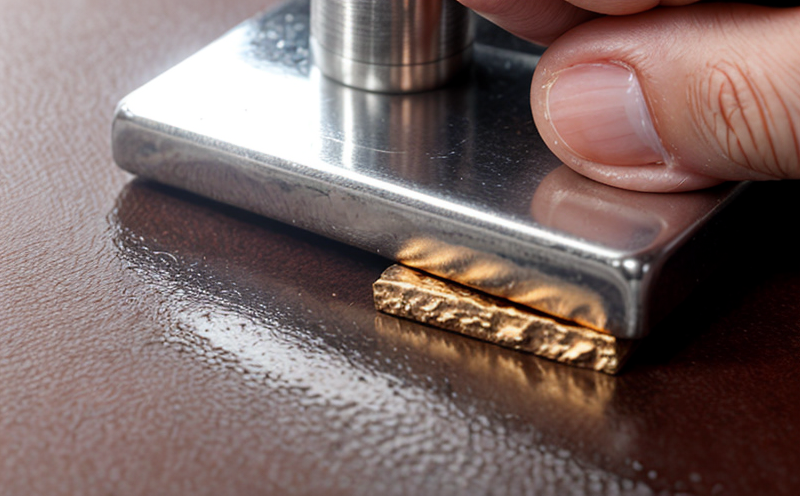ISO 11494 Determination of Base Metals in Alloys Testing
The ISO 11494 standard provides a precise method for determining the concentration levels of base metals, such as iron (Fe), manganese (Mn), and silicon (Si), in various alloys. This testing is crucial for ensuring product quality, compliance with industry standards, and safety across sectors like mining, metallurgy, and manufacturing.
The process involves several key steps: sample preparation, dissolution of the alloy, and subsequent analysis using spectroscopy techniques. Sample preparation ensures that the alloy's structure does not interfere with the accuracy of the test results. The dissolution step typically uses nitric acid to break down the alloy into its constituent elements.
The spectroscopic method used can be either optical emission spectrometry (OES) or inductively coupled plasma-optical emission spectrometry (ICP-OES). These methods provide high precision and accuracy, allowing for accurate quantification of base metal concentrations down to parts per thousand. The standard specifies the acceptance criteria based on replicate measurements to ensure consistency.
Understanding the base metals content is essential for optimizing alloy properties such as strength, ductility, and corrosion resistance. By adhering to ISO 11494, manufacturers can ensure that their products meet specified quality standards and regulatory requirements. This testing is particularly important in industries where material integrity must be guaranteed, including mining operations involving iron ore extraction.
The standard also provides guidance on handling samples safely and efficiently, which is vital given the potential hazards associated with certain base metals like manganese and silicon. Proper laboratory practices are outlined to minimize risks and ensure accurate results. Compliance with ISO 11494 not only enhances product quality but also supports regulatory compliance and customer satisfaction.
Our testing services use state-of-the-art equipment and follow the latest industry standards, ensuring reliable and repeatable results. By leveraging our expertise in this area, clients can gain valuable insights into their alloy composition, which is essential for process optimization and product development.
Scope and Methodology
The ISO 11494 standard outlines a comprehensive approach to determining the concentration of base metals in alloys. The scope covers various alloy types, including but not limited to steel, cast iron, and wrought iron. It specifies the requirements for sample preparation, dissolution procedures, and analytical methods.
The methodology involves several critical steps:
- Sample Preparation: This includes cleaning the alloy specimens to remove any contaminants or surface coatings that could affect test results.
- Dissolution: The alloy is dissolved in nitric acid, which helps release the base metals into a solution suitable for analysis.
- Spectroscopic Analysis: Using either optical emission spectrometry (OES) or ICP-OES, the concentration of iron, manganese, and silicon is determined. These techniques provide high precision and accuracy, ensuring reliable results.
Acceptance criteria are based on replicate measurements to ensure that the results are consistent and reliable. The standard also provides guidance on handling samples safely, emphasizing the importance of minimizing risks associated with base metals like manganese and silicon.
Industry Applications
| Industry Sector | Application |
|---|---|
| Mining and Metallurgy | Determining the base metal content in iron ore to optimize extraction processes. |
| Steel Manufacturing | Ensuring compliance with quality standards for steel alloys used in construction. |
| Casting Industry | Monitoring the composition of cast iron to enhance product performance and durability. |
| Machinery Manufacturing | Evaluating the base metal content in wrought iron parts for critical applications. |
Customer Impact and Satisfaction
Our ISO 11494 testing services have a profound impact on our customers, providing them with accurate and reliable data that supports decision-making processes. By ensuring compliance with industry standards, we help our clients maintain a competitive edge in the marketplace.
Customer satisfaction is paramount to us, and we strive to exceed expectations by delivering high-quality results within tight deadlines. Our experienced team of analysts and technicians ensures that every test is conducted according to the latest ISO 11494 guidelines, providing peace of mind for our clients.
For quality managers and compliance officers, these tests are essential for maintaining product integrity and ensuring regulatory compliance. R&D engineers benefit from this data in optimizing alloy formulations and improving product performance. Procurement teams can use the results to source high-quality materials that meet specific requirements.





